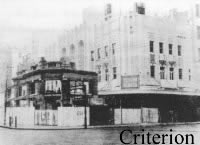

The Criterion Theatre, situated on the corner of Park and Pitt Streets in Sydney, was built for entrepreneur John Solomon, and opened on 27 December 1886.
Its auditorium, lit by a central chandelier, was decorated in light blue and gold, with seats upholstered in ruby plush and with boxes decorated with blue and gold-fringed brocade. Estimates of its capacity vary over time between nine hundred and ninety and over one thousand three hundred people. The stage had an unusual ruby plush tableau curtain, with a gold fringe. The accompanying act drop, reflecting the emergent and optimistic nationalism of the 1880s, featured a framed representation of the landing of Captain Cook and of the reading of the proclamation claiming the east coast of Australia for Britain.
The local press did not think its interior was impressive and the Government
Architect considered the theatre poorly ventilated and malodorous. The orchestra
was located under the stage and the dressing rooms in the basement under the
auditorium.Major remodelling took place in 1892, when the Brough-Boucicault
Company took a long lease on the theatre. The roof was raised, the stage altered
to thirty six feet deep and fifty eight feet wide, the stage boxes all but abolished,
a scene dock and above stage dressing rooms added and a sliding roof installed.

The auditorium colour scheme, reflecting the contemporary fashion for Moorish style, was changed to a design in pale blue, pale green, fawn, cream and old gold. The proscenium was made more rectangular in shape, and was painted with scenes depicting `The Seven Ages of Man', while the act drop was changed from nationalist imagery to a scene of the interior of a Moorish palace. The Criterion was again remodelled in 1905, with major changes this time aimed at improving the fire resistance of ceilings and woodwork.
The theatre was leased to J. C. Williamson's in 1915 and it was used as their Sydney outlet for West End comedies. In 1920, following the amalgamation of J. C. Williamson Pty. Ltd. and J. & N. Tait, it came under their full control. Under the influence of depression and commercial requirements, the theatre was then closed on 13 July 1935, and a year later demolished.
Sources:
I. Bevan, The Story of the Theatre Royal (Sydney, Currency Press, 1993)
E. Irvin, Dictionary of the Australian Theatre 1788-1914 (Sydney, Hale
& Iremonger, 1985)
P. Parsons (ed.) with V. Chance, Companion to Theatre in Australia (Sydney,
Currency Press in association with Cambridge University Press, 1995)
J. West, Theatre in Australia (Stanmore, Cassell, 1978)